Key Takeaways
- Following on the success of GIS Day, a Wellesley College team planned and implemented a Digital Scholarship Day to highlight the ways innovative technologies already support digital instruction and research at the college.
- The wide range of speakers met a five-minute limit — or were "gonged" off the stage.
- Posters, snacks and cake, and a playground makerspace gave attendees an opportunity for informal interaction, contributing to the event's success and plans for 2015.
Rebecca Darling is assistant director, Instructional Technology, Wellesley College.
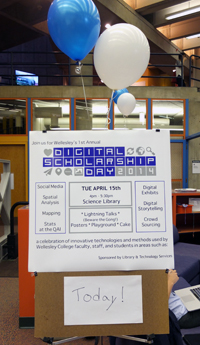
Photo by Carolin Ferwerda
Figure 1. Digital Scholarship Day
event poster
Wellesley's Digital Scholarship Day is an opportunity for the entire Wellesley College academic community to celebrate the ways innovative technologies and methods support instruction and research. We wanted to create an event featuring work from all areas of the Wellesley academic community — faculty, students, and staff — in a format that allowed for a more open and playful approach than the ones Wellesley commonly has at talks. It worked. We had a full panel of faculty, staff, and student speakers representing a broad range of disciplines and specialties (figure 1).
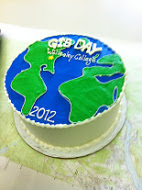
Photo by Rebecca L. Darling
Figure 2. GIS Day cake,
design by Carolin
Ferwerda
When Wellesley announced a new Digital Scholarship Initiatives program last year, we knew we wanted to showcase the digital scholarship work already happening at the college. We already had one example of a successful showcase on campus in the form of GIS Day. Carolin Ferwerda, instructional technology specialist for Numeric and Spatial Data, has held successful GIS Day events in 2010, 2011, and 2012. At Wellesley, GIS Day highlights mapping across disciplines using posters and speakers from on campus and off, swag, and — most importantly — cake (figure 2). Typically, GIS Day is held as part of a worldwide event on the third Wednesday of November, but this year we couldn't hold it in the fall and decided to fold it into Digital Scholarship Day. Next year, we'll hold two events: GIS Day in the fall and Digital Scholarship Day in the spring. Due to GIS Day's success — each year, it has gotten bigger with a solid core of speakers, more posters, and more attendees — we chose to model Digital Scholarship Day after GIS Day, but with a few tweaks. As Ferwerda noted,
"Like GIS Day in previous years, Digital Scholarship Day [is] a wonderful way to bring together faculty, staff, and students from diverse departments. I see events like GIS Day and Digital Scholarship Day as a means to build a community of users and to foster cross-pollination of ideas and tools between disciplines. ... I love being able to provide a forum to highlight their work."
Planning the Event
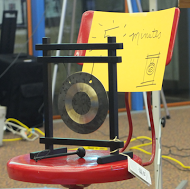
Photo by Carolin Ferwerda
Figure 3. Gong used to stop
speakers if they passed the
time limit
Digital Scholarship Day has a broader focus than GIS alone, so we gathered a team of four to help plan the event. Between us, we represented the central topics we wanted to focus on this year: Jenifer Bartle, manager, Digital Scholarship Initiative; Carolin Ferwerda, instructional technologist, Numeric and Spatial Data; Cassandra Pattanayak, the Jack and Sandra Polk Guthman '65 Director of the Quantitative Analysis Institute; and myself, assistant director, Instructional Technology. Each one of us invited faculty, staff, and students we thought would have interesting projects, assignments, or classes to present a talk on at our first Digital Scholarship Day this spring.
We kept the talks element from GIS Day, but to make them more playful, we took an idea I saw for the first time at the New Media Consortium Conference: We asked the speakers to give five-minute lightning talks. If the speaker exceeded the time limit, a gong interrupted the talk (figure 3). We tried to be very clear about the format and the consequences. We wanted our speakers to be on board with the process and understand the constraints before they agreed to participate. Bryan Burns, Classical Studies professor, found the abbreviated lightning talk format to be beneficial: "The opportunity to present a short summary encouraged me to assess the state of an on-going project and to reevaluate the goals of our work in relation to an academic audience from other disciplines."
Using lightning talks also allowed us to present a lot of content — 12 talks in one hour. To do this, we set up two podiums, one on either side of the screen (figure 4). While one speaker was talking, I was helping the speaker on deck get their laptop and files ready, so I could immediately move from one speaker to the next. I was pleasantly surprised how smoothly this worked out, with no dress rehearsal or any real prep to speak of. Our speakers were so well prepared, we only had to use the gong once.

Photo by Carolin Ferwerda
Figure 4. Setup for the lightning talk speakers
After the talks, it was time for posters, snacks and cake (figure 5), and the playground, all hosted in the Science Library as well. This was an informal opportunity for conversations and questions sparked by the lightning talks, since the fast pace didn't allow for questions during the talks. Attendees and presenters could also choose to spend the time reading posters and conversing with the posters' authors, if they were present. We even invited people to ring the gong, since they didn't really get a chance to hear it during the talks. We also created a playground to publicize our new makerspace tools and encourage hands-on engagement, experimentation, and play.
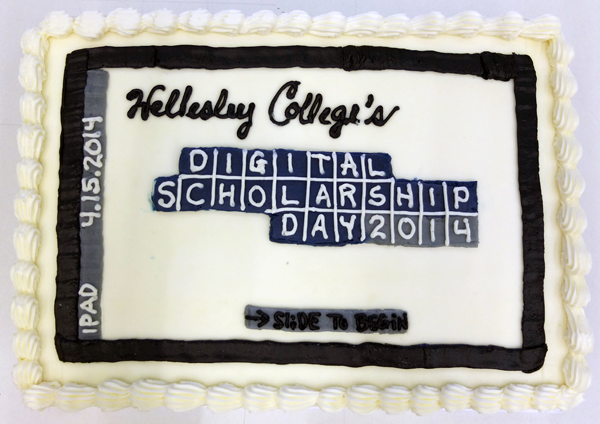
Photo by Carolin Ferwerda
Figure 5. Digital Scholarship Day cake
Many of our maker tools require some orientation and training before you can use them. We tried to select items for the playground which attendees could figure out on their own. In the playground, attendees could play Leap Motion motion controller games projected on the big screen we used for the talks. This allowed many people to see the game and the control even though only one person at a time could interact directly with the game. We hoped watching others play would make people curious to try out the device themselves, but it didn't seem to catch on.
The Makerbots require training before use, and we decided not to bring the actual printers to the playground this year. Instead, we used the new equipment to create two 3D printed catapults, along with their ammunition and targets (figure 6). This way, people could at least see what the printers could do, and they could play with the items instead of simply handling sculptural objects. While people lingered for half an hour longer at the post- lightning talk activities than we expected, the playground is definitely one of the aspects we can improve.
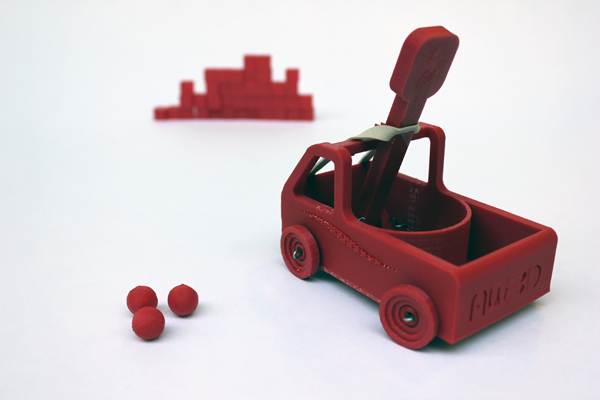
Photo by Iva Gishin
Figure 6. Small catapult with ammunition and target
Planning for 2015
We expect the same team of people will be responsible for planning next year's Digital Scholarship Day. We'll be keeping the parts that worked well, such as the lightning talks and directly contacting faculty, students, and staff we believe have good projects to feature on Digital Scholarship Day, and we've already discussed some changes.
For next year's Digital Scholarship Day, we'd like to devote more planning to the playground and posters. Because we were so focused on the lightning talks, the playground and posters got lost in the shuffle, and a half hour didn't seem to be enough time for people to have a conversation, peruse a poster, and play. We're tempted to make the lightning talks even shorter. Most of our speakers finished with time to spare, and we could add the extra time to the more informal part of Digital Scholarship Day. The playground activities themselves needed a little more guidance before people felt comfortable trying them out. For example, the Leap Motion device is just a little box. It doesn't display the tutorial if someone has already run it, and its controls are unfamiliar to most. A short explanatory sign or a brief introduction would make a big difference in getting someone started using it.
Ideally, we start advertising events 6-4 weeks in advance using blog announcements, digital signage, direct department contacts from academic liaisons, and speaking with faculty and student presenters to encourage friends and relevant classes to attend. Considering we did our first posting for the event one week before we held it, we did quite well. We estimate we had roughly the same number of people attend our first Digital Scholarship Day as Ferwerda had for her first GIS Day in 2010, about 20 or so. The Science Library is a convenient place for people to stop and watch for a few minutes as they're coming and going, and in figure 7 you can see people who stopped and watched from the space above the library, so exact numbers for people who stayed for even one lightning talk might be higher.
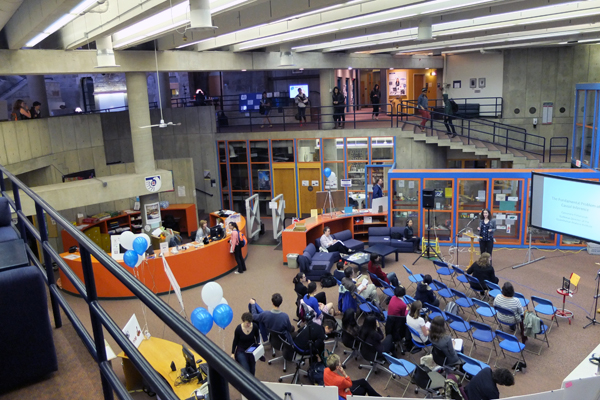
Figure 7. View of the event space in the Science Library
Overall, the event went well. We wanted a full panel of speakers and posters that included faculty, students, and staff; we wanted the topics to be diverse and engaging; and we wanted the attendees and presenters to have fun while learning — and we succeeded. Professor Jay Turner in Environmental Sciences commented:
"It was one of the most exciting hours I've spent recently thinking about pedagogy. Every five minutes, someone new got up and explained how they were using technologies — ranging from digital storytelling to tweeting — to improve their teaching and research. I came away with at least three ideas for my classes next year."
With feedback like that, and our own lessons learned, we're really looking forward to our second Digital Scholarship Day in the spring of 2015.
© 2014 Rebecca Darling. The text of this EDUCAUSE Review online article is licensed under the Creative Commons Attribution-NonCommercial-ShareAlike 4.0 International license.
